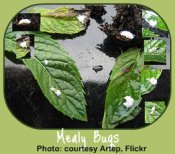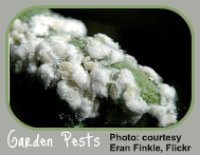- Home
CARE for your HOUSE PLANTSGROWING HOUSE PLANTSCHILDREN & PETS & PLANTSGIFTS for the INDOOR GARDENERSCIENCE of HOUSE PLANTSSITE LOGISTICS- Tell your story
|
Mealy Bugs
Info for the Indoor Gardener
Mealy bugs are among the garden pests the Indoor Gardener will probably face at some point or other. They multiply quickly, create havoc on your houseplants, and need to be identified quickly and eradicated immediately. The information on this page will help you accomplish just that.
DESCRIPTION
- Mealy bugs appear as small, white, fuzzy spots on your houseplants
- 1/8th to 1/10th inch
- flat, oval, some with tails
- some species have a pinkish cast to them
- some species have little filaments surrounding their edges
- create a white, waxy coating around themselves
- mouth have piercing parts that suck sap from the plant
- looks like cottony fur
- eventually, dark gray or black mold forms ("sooty mold")
- adult males fly; females don't

LOCATION
- stems at leaf joints
- under leaves
- anywhere on the plant as the mealy bugs multiply
- young leaves, flower buds
- in soil if plant's not healthy
MULTIPLICATION
- spread by wind (ie: fan)
- ants can spread them
- proximity to other plants
DESTRUCTION
- some species devour roots
- suck sap and life out of the houseplant from leaves and stems
- sooty mold prevents photosynthesis, further depleting the energy of the plant
DETECTION
- you'll notice the white, sticky fuzz
- if you have ants on your houseplants, you probably have mealy bugs. Ants find the sweet, sticky emissions called "honeydew" irresistible.
- plants look dry even after watering
- examine plants every few weeks with a magnifying glass for early detection of these common garden pests
- wilting, yellowing leaves
- loss of leaves
SOLUTION
- easy - medium
- isolate the plant as soon as you notice the problem
- catch it early and cut the branches with the bugs immediately
- wipe the plant with water and a sponge: pay special attention to angles where the leaves join the stem
- spray with 10% rubbing alcohol, a few drops of dishwashing soap, and water once weekly for at least three weeks
- cotton swabs dipped in rubbing alcohol, though it's hard to find the young crawlers; repeat the procedure a few times
- commercial spray: sources mention pyrethrin, diazinon, azadirachtin, resmethrin; wet the plant (and the bugs) first
- insecticidal oils may work better than soaps as they'll suffocate the garden pests rather than trying to penetrate their protective coating
- sprays and oils work best in cool temperatures and a day after watering your infected house plant
- systemics: disulfoton, imidacloprid, others
- use yellow sticky cards to trap adult male mealy bugs and stop reproduction cycles
- if you have a large indoor garden, conservatory, or greenhouse, you can invest in natural predators: the ladybug, Cryptolaemus montrouzeri, is known as the "Mealybug Destroyer"
- if the plant is seriously infected, it's best to get rid of it
For Botanists, Scientists, Outdoor Gardeners, and School Reports

Order: Homptera
Family: Pseudococcidae
- Outdoors: not much problem; ants eat honeydew-like excretions that contain the eggs; ladybugs feast on mealy bugs
- Some species prey only on roots; others move to the roots if the plants aren't strong enough to feed them with the sap.
- There are 275+ species in the U.S. alone; more live everywhere but the Arctic areas.
- The two major species of this garden pest are: citrus mealybug (Planococcus citri) and longtailed mealybug (Planococcus longispinus.
- The waxy coating protects them from many insecticides.
- Favorite indoor plants: African violets, cacti, coleus, croton, fuschia, gardenias, jade, lantana, poinsettia, succulents.
- Life cycle = about a month
- females create cottonlike excretions in which to lay as many as 600 eggs
- eggs grow in the white, downy spots called "ovisacs"
- eggs hatch in a few days (6 - 14, depending on species)
- longtail mealybugs skip the egg stage and give birth to live crawlers
- hatch into "crawlers"
- female crawlers mature through four stages; males through five
- Mouth section that pierces into the plant to suck the sap is called the "stylet."
DISCLAIMER: The Indoor-Gardener.com provides information through data research and personal experience and does not mean to recommend or refute any product used for insect control inside or outside the house. Read and follow instructions carefully as listed on all products. Indoor-Gardener.com is not responsible for use of any product or method described on these pages, nor for any possible adverse affects of such use. The legal use of chemicals for plant health can change, and it is solely the responsibility of the user of such chemicals to remain in compliance with such laws. Indoor-Gardener.com and Batya D. Wininger assume no liability resulting from the use of any information on these pages. While this website does its best to provide only the best, up-to-date information to its visitors, there can be changes and mistakes. Read labels carefully and follow instructions for use.
Back to Top of Page
Return to Garden Pests
Return to Home Page
|
|
|

